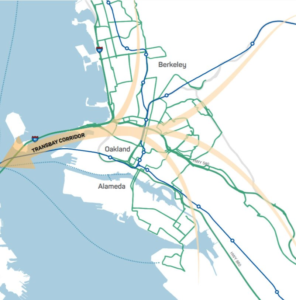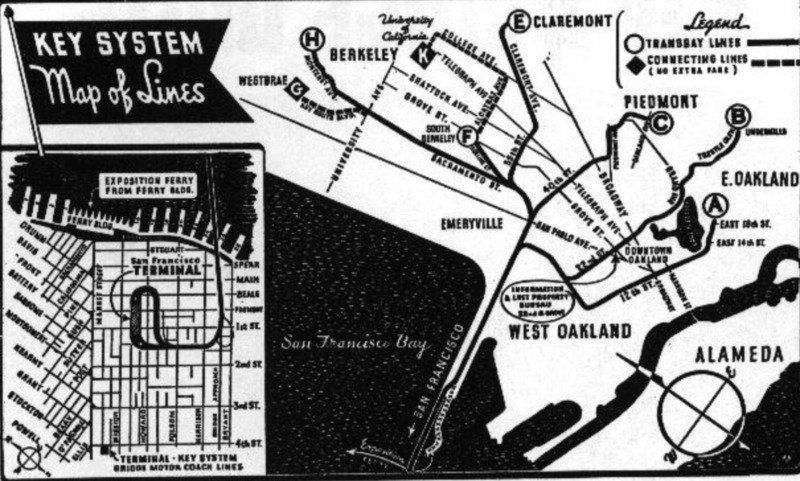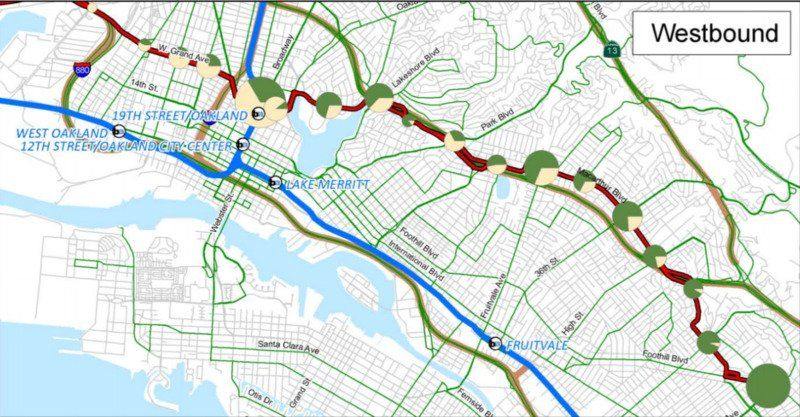
While the Bay Area engages in a spirited debate over increasing bridge tolls, AC Transit is quietly moving forward with a big increase in Transbay fares.
Despite substantial Transbay ridership growth over the past five years, the agency is facing an unfortunate funding crunch associated with outstanding financial commitments toward the Transbay Transit Center, which opens this spring.
Rather than optimizing Transbay services to maximize ridership demand and create a more efficient and equitable system, the agency’s fare proposal is poised to initiate a negative feedback loop that reduces ridership and makes transit less accessible to lower and middle-income households.
AC Transit’s fare proposal would make Transbay buses the most expensive transit service for commuters traveling to San Francisco from most of the inner East Bay. The proposed fare increase would raise the cost of a single ride/monthly pass from $4.50/$162 to $5.50/$198 beginning later this year, then $6.00/$216 next year and $6.50/$234 in 2021.
For the core Transbay service area spanning Oakland, Berkeley, Alameda, Piedmont, Emeryville, and El Cerrito – an area that accounts for 84 percent of the agency’s 18,000 daily Transbay riders – Transbay fares would be more expensive than BART fares for single rides ($3.25-$4.55) and equal or more expensive than BART on a monthly basis ($143-$200).
Fares would also be more costly than bus-to-BART transfers in downtown Oakland ($5.30), ferry service from Alameda and Oakland ($5.10-$5.30), and casual carpool (optional donation of $1).
Fare Comparison – Transbay Bus vs. BART/Ferry
| Sample Origin | BART/Ferry
One Way Fare (Monthly) | Casual Carpool | Current AC Transit
One Way Fare (Monthly) | Proposed AC Transit
One Way Fare (Monthly) |
| El Cerrito Plaza | $4.40 ($194) | $0-$1
($0-$44) | $4.50 ($162) | $5.50 ($198) |
| 19th Street (Oakland) | $3.50 ($154) | |||
| Coliseum (Oakland) | $4.30 ($189) | |||
| Fremont | $6.30 ($277) | |||
| Alameda Main Street Ferry | $5.10 ($224) |
All fares assume use of Clipper card. Monthly fares assume 22 workday roundtrips per month.
Will riders pay a premium for a slower, less frequent, and less reliable service than BART and other alternatives? AC Transit expects ridership to stagnate after the fare increase.
Back in 2013, Transbay routes were struggling, serving 11,000 riders per day (6 percent of the agency’s total ridership). Since then, ridership has increased by over 60 percent to 18,000 riders per day (11 percent of the agency’s ridership). Assuming riders are not very sensitive to a change in fare, the agency expects ridership to decrease by about three percent after the initial $1 increase.
However, much of this recent success occurred not because of improvements to Transbay services, but due to commuter frustrations with crowded BART trains – an issue that may be assuaged with new higher capacity train cars starting this year. If AC Transit doesn’t improve the efficiency of its Transbay network, its ridership gains may be fleeting, and losses could be heavier than expected.

Six of AC Transit’s Transbay routes derive from the Key System, the East Bay’s original streetcar network in the 1940s and 1950s. Source: LocalWiki
Nearly unchanged for over a half-century, AC Transit’s core Transbay system is rife with inefficiencies. Fourteen Transbay routes predate the opening of the BART system (see 1960 and 1968 maps), and six routes (B, C, E, F, G, and H, shown above) were part of the original Key System streetcars in the 1940s. While some segments of the Roosevelt- and Kennedy-era Transbay routes remain highly productive – serving densely-populated areas that still lack convenient access to BART – other segments make little sense in the 21st Century. A review of 2017 ridership data, route fact sheets from the Transbay Tomorrow study, and previously developed route profiles and system summaries illuminates inefficiencies such as the following:
- Sixty-two percent of trips on the two busiest Transbay routes (NL and F) do not cross the Bay, instead riding for local trips or to access BART.
- Low-density, high-income neighborhoods like Trestle Glen, Claremont, Kensington, and Upper Rockridge are served by unproductive routes, while high-density, low- and middle-income neighborhoods in East Oakland and Richmond are hardly served.
- Seven routes (C, E, F, G, L, LC, and NL) have large segments that are redundant to BART, but struggle to compete due to unreliable travel times often twice as long with half the frequency.
- Service levels are infrequent and spread thin: 20 of 28 Transbay routes do not provide peak service frequencies at least every 15 minutes and are therefore not useful without planning ahead.

The NL is AC Transit’s busiest Transbay route, but two-thirds of riders do not cross the Bay. Source: AC Transit
There is a legitimate argument questioning whether much of the Transbay bus system should even exist. Transbay buses attract the type of riders that you’d expect for a system planned prior to the Civil Rights movement: riders are much wealthier and whiter than Local riders.
A majority of Transbay riders earn greater than $100,000 per year per household, compared to a majority of Local riders earning less than $25,000 per year per household; moreover, two-thirds of Transbay routes do not serve what the agency designates as minority communities, compared to one-quarter of Local routes. While it’s possible such demographics generate higher demand for Transbay travel, AC Transit has never published a study that confirms dense lower income neighborhoods like Oakland’s San Antonio district or 98th Avenue corridor would underperform current low-ridership services in Trestle Glen or Upper Rockridge.
Comparing Transbay and Local riders is not a false choice: every dollar that the agency spends subsidizing Transbay service comes at the expense of providing additional Local service to riders in need. Subsidizing unproductive services to higher income white communities while underfunding high demand service in lower-income communities that lack other options is… not good.
Despite the agency’s funding gap and its outdated, inefficient, and inequitable system, AC Transit continues to avoid significant changes to its Transbay network. The agency’s new Transbay Tomorrow study identifies a number of worthwhile improvements such as stop consolidation, minor route modifications, and transit priority treatments, but by and large maintains the status quo.
Transbay Tomorrow inexplicably fails to mention the agency’s need to maximize revenue for its Transbay Terminal debts and to restructure its services around its most productive areas that enjoy a travel time advantage over BART. Instead, the agency continues to preserve a bus network that predates the Beatles and mostly serves people like John, Paul, George, and Ringo.
Some Transbay routes will continue to thrive after the fare hikes due to their competitive travel times over BART: Alameda, Emeryville, and Albany, for example, present strong markets that won’t get BART stations anytime soon.
However, routes that do not offer travel time advantages to riders and rely solely on the luxury value of getting a seat risk losing riders to improvements by competing services. If fare hikes do in fact push these riders away, all commuters will be affected, especially those who ride AC Transit’s Local routes who will foot the bill of lost revenue. AC Transit should build a resilient Transbay network that maximizes ridership and reduces inefficient and redundant services, both to serve its own financial interests and to optimize public benefits.

